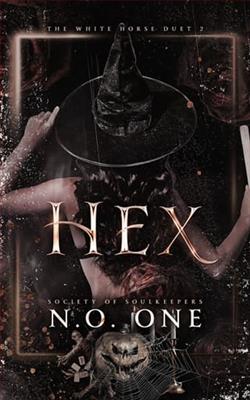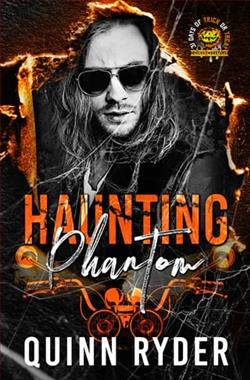Page 44 of The Devil Colony (Sigma Force 7)
“I thought he wanted to stay off the grid.”
The Humetewas’ cabins had no television or telephones. Even cellular reception was nonexistent in the labyrinthine canyons.
She shrugged. “Should still be safe. I heard him say something about encryption software. Probably acts as a scrambler or something.”
He nodded and patted the stone. “You came all the way up here to tell me that?”
She sank cross-legged to the stone. “No . . .” There was a long pause, too long for the truth. “Just wanted to stretch my legs.”
He recognized the waffling and could guess its source. He had already noted how she shied away from her uncle, circled him like a wary dog fearful of being beaten but drawn anyway. Still, there was no timidity to her. She kept her hackles raised, ready to bite. All this uncertainty must have made it too uncomfortable for her to stay below at the cabins, pushing her to follow after him.
He faced the rising sun as it crested fully and set fire to the red-rock landscape below. “Are you familiar with the na’ii’ees ceremony?”
“What’s that?”
He shook his head sadly. Why was it that the most fervent of the Native American activists were so often ignorant of their own heritage?
“It’s the sunrise ceremony,” he explained, pointing to the blazing birth of the new day. “A rite of passage for girls into womanhood. It involves four days and nights of dancing and sacred blessings, imbuing the new women with the spiritual and healing power of the White Painted Woman.”
Answering the questioning lift of an eyebrow, he explained the Apache and Navajo mythology surrounding this goddess, also known as the Changing Woman, named for her ability to shift appearances along with the seasons. He enjoyed how her gaze turned from dull to rapt with the telling, a sign of her thirst for such knowledge.
As he ended his description, she turned to the rising sun. “So do any tribes still perform the ceremony?”
“Some, but rarely. In the early twentieth century, the U.S. government banned Native American spiritual rites and practices, making the sunrise ceremony illegal. Over time, the practice slowly faded, only to return in a weakened version today.”
Kai’s face turned darker. “They’ve stolen so much from us . . .”
“The past is the past. It’s now up to us to sustain our own culture. We only lose what we fail to nurture.”
She seemed little mollified by this, her words bitter. “What? Like you’re doing? Forsaking your own beliefs for the white man’s religion. A religion that persecuted our people and incited massacres.”
He sighed. He’d heard it all before, and once again tried his best to enlighten the ignorant. “Mistakes are made by stupid men. In the course of human history, religions have been used as excuses for violence, including among our own Native American tribes. But when it comes to culture, religion is only one thread in a vast woven rug. My father was raised Mormon, as was my mother. That is as much my history as my native blood. One does not negate the other. I find much in the Book of Mormon that gives me peace and brings me closer to God—or whatever you want to call that eternal spirituality that exists in all of us. In the end, my faith even offers another viewpoint on our own people’s past. It’s why I became a Native American historian and naturalist. To seek the answer to who we are.”
“What do you mean by that? How does Mormonism explain anything about our people?”
He wasn’t sure this was the right time to explain the history that was buried within the pages of the Book of Mormon, a testament of Christ’s footsteps in the New World. Instead, he’d offer Kai some insight into the shadows that still clouded the earliest histories of the Native American tribes.
He stood up. “Follow me.”
With a slight arthritic limp, he hobbled over to a neighboring scalloped-out dome of sandstone. Under a fluted lip of rock stretched a line of chipped stone blocks, marking the ruins of an old Indian home. Ducking his head, he stepped over the threshold and crossed to the far wall.
“There is much that we still don’t know about our own people,” he said, and glanced back. “Are you familiar with the prehistoric Indian mounds found throughout the Midwest—stretching from sites around the Great Lakes to the swamps of Louisiana?”
She shrugged.
“Some mounds date back six thousand years. Even tribes living in the area when Europeans arrived had no memories of those ancient mound builders. That is our heritage. One big mystery.”
He reached the far wall, where some prehistoric artist had painted a trio of tall, skeletal figures in crimson pigments against the yellow sandstone. He lifted a hand over the ancient artwork.
“You’ll find petroglyphs like this throughout the area. Some archaeologists have dated the oldest images here at eight thousand years old. And those are relatively new compared to the Coso Petroglyphs above China Lake’s salt beds. Those go back sixteen thousand years, to the end of the last Ice Age, when the continent was still roamed by mammoths, saber-toothed cats, and monstrous Pleistocene bison.” He turned to Kai. “That is how far back our history goes, with so little known.”
He allowed the weight of ages to press down on her young shoulders before continuing. “Even the number of people who lived here has been vastly underestimated. Newest studies from the chemical composition of stalagmites, and the depth and breadth of charcoal deposits found throughout North America, put modern estimates of Native American populations at well over a hundred million. That’s more people than were living in Europe when Christopher Columbus set foot in this New World.”
Her eyes shone large in the shadowy space. “Then what happened to them all?”
He waved to encompass the ruins as he led the way back out. “After the Europeans arrived, infectious diseases like smallpox spread faster across the continent than the colonists, leading to the impression of a sparsely populated American wilderness. But that is a false history, much like the rest of it.”
Kai joined him back on the rocky outcropping, along with Kawtch, who had his nose in the air. She wore a thoughtful expression as she stared out. The skies had shed the rose of dawn for the deeper blue of morning.
“So I get your point,” she said. “We can’t truly know ourselves until we know our own history.”
He looked to her, sizing her up anew. She was far sharper than she let on—proving it again when she turned to him to ask, “But you never did say how the Book of Mormon offered insight into our history.”















